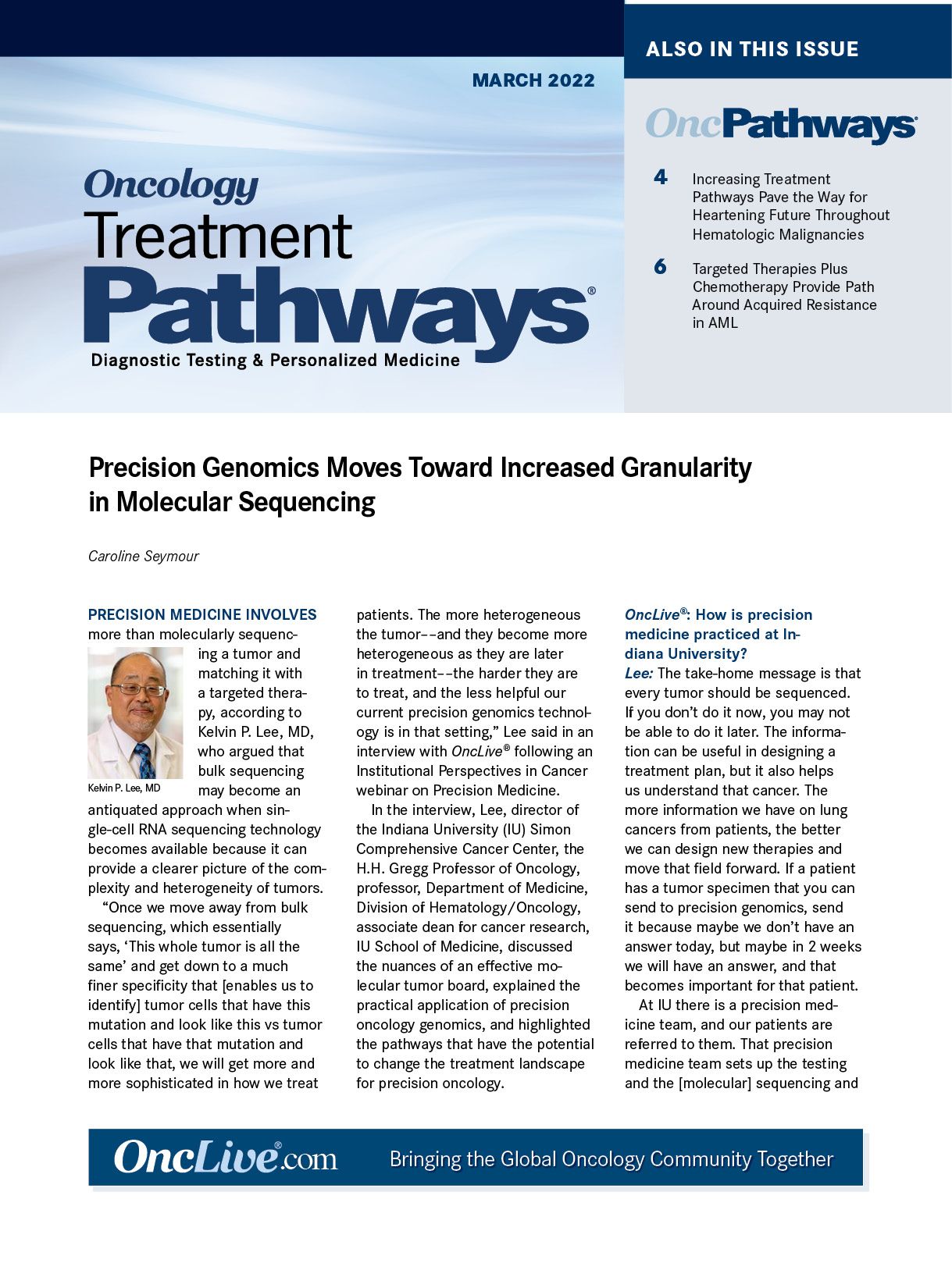Publication
Article
Oncology Treatment Pathways®
Targeted Therapies Plus Chemotherapy Provide Path Around Acquired Resistance in AML
Author(s):
Targeted therapies, specifically those agents directed at mutated proteins and aberrant protein-to-protein interactions, have been shown to improve survival among patients with relapsed or refractory acute myeloid leukemia.
Eytan M. Stein, MD

Targeted therapies, specifically those agents directed at mutated proteins and aberrant protein-to-protein interactions, have been shown to improve survival among patients with relapsed or refractory acute myeloid leukemia (AML). However, developed resistance to targeted therapies has proved to be a problem, according to a presentation by Eytan M. Stein, MD, during the 26th Annual International Conference on Hematologic Malignancies®.1
“The challenge of single-agent inhibitors is [developed] resistance,” Stein, director of the Program for Drug Development in Leukemia, Memorial Sloan Kettering Cancer Center in New York, New York, said. “We can overcome the resistance by moving agents upfront in combination with broadly active standard of care agents, [such as] chemotherapy.”
Addressing RAS Pathway Mutations
FLT3
Approximately 30% of patients with AML display mutations in the FMS-like tyrosine kinase 3 receptor (FLT3). Among these patients, 23% have FLT3-internal tandem duplications (FLT3-ITD) and 7% have FLT3-tyrosine kinase domain mutations (FLT3-TKD).2 Several agents have been investigated in the space, however a lack of prolonged efficacy remains a challenge for their integration into clinical practice.
Investigators evaluated midostaurin, a multitargeted tyrosine kinase inhibitor, in patients with wild-type or FLT3-mutant relapsed or refractory AML or MDS in a phase 2B study (NCT00045942). Among the 95 patients enrolled in the study, 35 were FLT3-mutant and 57 had wild-type disease. Patients were treated with 50 mg or 100 mg of midostaurin twice daily.
Patients with FLT3-mutant disease experienced an overall response rate (ORR) of 71%, with all responses being blast responses. Patients with wild-type disease had an ORR of 56%; 24 patients had a blast response. The study authors concluded that midostaurin displayed hematologic activity in both patients with FLT3-mutant and wild-type disease, but there were no clear differences in the blast responses when stratified by type of FLT3 mutation or dose of study drug.
“Midostaurin is a relatively weak FLT3-inhibitor,” Stein said. “[Investigators observed] some decrease in the level of blast, but nothing that was good enough to be a true complete remission [CR]. In the relapsed or refractory setting, midostaurin has very little, if any, significant clinical activity.”
In the phase 3 QuANTUM-R trial (NCT02039726), the potent, selective type 2 FLT3 inhibitor quizartinib was compared with salvage chemotherapy in patients with relapsed/refractory FLT3-ITD–positive AML. Patients were randomized 2:1 to received either quizartinib (n = 245) or salvage chemotherapy (n = 122) and the primary end point of the study was overall survival (OS). At a median follow-up of 23.5 months (range, 15.4-32.3), the median OS in the quizartinib group was 6.2 months (range, 5.3-7.2) compared with 4.7 months (range, 4.0-5.5) in the chemotherapy group (HR, 0.76; 95% CI, 0.58-0.98; P = .02).3
Stein noted that although a survival benefit was observed with single agent quizartinib, the FDA did not approve the drug, but it has been approved for use in Japan.
In a similar phase 3 study, ADMIRAL (NCT02421939), the FLT3-inhibitor gilteritinib (Xospata) was compared with salvage chemotherapy in patients with relapsed or refractory AML harboring a FLT3-ITD mutation. Patients were randomized 2:1 to received either gilteritinib (n = 247) or salvage chemotherapy (n = 124). The primary end points of the trial were OS and CR/CR with partial hematologic recovery (CRh) rate. Patients treated with gilteritinib experienced a median OS of 9.3 months s 5.6 months in the salvage chemotherapy arm (HR, 0.665; 95% CI, 0.518-0.853; 2-sided P = .0013).4
“You will notice in both of these studies that there is a tail to the curve, where almost no patients end up surviving very long,” Stein said. “And if you just gave these patients FLT3-inhibitors and didn’t follow that up with an allogeneic stem cell transplant, I would argue that nearly all of these patients end up relapsing by a year after going on therapy, whether they go on quizartinib or gilteritinib.”
Stein explained that the 3 most common mutations among patients who relapsed on gilteritinib were FLT3-F691L, NRAS, and KRAS. The FLT3-F691L mutation is a “gatekeeper mutation” that can prevent the binding of gilteritinib, reducing efficacy and ultimately leading to resistance against the agent, Stein said. The RAS mutations then become the driving mutations in disease growth via clonal evolution.5
IDH1/2
Another mutation type common in patients with AML are mutations of isocitrate dehydrogenase 1 (IDH1) and isocitrate dehydrogenase 2 (IDH2), which are observed in up to 25% of patients with AML. Patients with an IDH1 or IDH2 mutation experience an increase in intracellular beta hydroxyglutarate, freezing the cell in an undifferentiated state, Stein said. IDH1 and IDH2 are mutations of clinical interest because if effectively drugged and the intracellular beta hydroxyglutarate is decreased, cells will begin differentiating again and patients will go into a complete clinical remission, Stein explained.
The IDH1 inhibitor ivosidenib (Tibsovo) was examined as a single agent in patients with relapsed or refractory AML harboring an IDH1 mutation in a phase 1 trial (NCT02074839). In the primary efficacy population (n = 125), the median OS was 9.0 months (95% CI, 7.1-10.0). Among patients who experienced a CR or CRh (n = 38), the median OS was 18.8 months (95% CI, 14.2-not estimable [NE]). Similar to patients treated with FLT3 inhibitors, a drop off in survival was seen around 12 to 16 months because of relapse, Stein noted.6
Enasidenib (Idhifa), an IDH2 inhibitor, was also tested as a single agent in patients with IDH2-mutant AML in a phase 1/2 trial (NCT01915498). The efficacy results with enasidenib were very similar to those seen with ivosidenib, Stein noted. Specifically, the median OS was 8.8 months (95% CI, 7.8-9.9) among all treated patients (n = 214) and the median OS for patients who achieved a CR (n = 42) was 18.9 months (95% CI, 14.5-24). The same drop in survival at the tail of the curve was observed.7
“The most common causes of relapse [among patients treated with IDH inhibitors] are RTK pathway mutations and [new] mutations in IDH,” Stein said. “One of the mutations in IDH can be a second site mutation that can prevent drug binding. The other mutations that we see in IDH are what we call isoform switching. Isoform switching is a mechanism of clonal evolution, when you have a patient with IDH2-mutant AML and you give them an IDH2 inhibitor, there are some cases where IDH1 mutation then pops up and takes over driving the disease.”
Stein went on to explain that the same mechanism of isoform switching can occur where IDH1-mutant disease can switch to IDH2-mutant disease. Any new targeted therapy will eventually experience problems with resistance, more than likely through second site mutations or clonal evolution, Stein said.
Tackling Resistance
To overcome problems with resistance, targeted therapies are being examined in combination with intensive chemotherapy. Midostaurin plus chemotherapy was evaluated in patients with AML harboring an FLT3 mutation in a phase 3 trial (NCT00651261). The study design consisted of 1 to 2 cycles of induction chemotherapy (cytarabine plus daunorubicin) plus midostaurin or placebo. If patients achieved CR, consolidation high-dose cytarabine was administered in combination with midostaurin or placebo for 4 cycles. If CR persisted, patients received single-agent targeted therapy for 12 cycles.
Patients treated with the combination experienced a median OS of 74.7 months (95% CI, 31.5-not reached) compared with 25.6 months among patients who received placebo (HR, 0.78; 95% CI, 0.63-0.96; P = .009).8
Another phase 3 trial combining a targeted therapy with chemotherapy, QuANTUM-First (NCT02668653) displayed positive topline results. The trial met its primary end point for OS and the combination was found to be manageable in terms of safety.9
Similarly positive results have been observed when IDH inhibitors are combined with induction chemotherapy, followed by consolidation, and single-agent maintenance therapy. In a phase 1 study (NCT02632708), patients with IDH1 mutations received ivosidenib 500 mg once daily and those with IDH2 mutations received enasidenib 100 mg once daily. For those treated with ivosidenib, the median OS was not reached, and the 12-month survival probability was 78% when evaluated after induction on day 1. Among patients treated with enasidenib plus chemotherapy, the median OS was 25.3 months (95% CI, 25.5-NE) and the 12-month survival probability was 74%.10 Stein noted that the same design is now being done as a randomized phase 3 trial in Europe.
In the phase 3 AGILE study (NCT02677922), ivosidenib was combined with azacytidine (Onureg) and evaluated in patients with AML harboring an IDH1 mutation. Patients treated with the combination (n = 100) experienced a median OS of 24.0 months compared with 7.9 months among the 100 patients who received placebo plus azacitidine (HR, 0.44; 95% CI, 0.27-0.73; P = .0005).11
“[These results] argue that we should be combining some of these targeted agents, [such as] FLT3 inhibitors and IDH inhibitors, with intensive chemotherapy to eliminate the most common source of clonal evolution, which is RAS-mutant disease,” Stein said. “Maybe there will be other better targeted therapies for KRAS-mutant disease, [but] combining targeted therapies with more broadly active treatments like chemotherapy and hypomethylating agents is really the way to go.”
References
- Stein EM. Clinical benefits and challenges with targeted therapies in AML. Presented at: 26th Annual International Conference on Hematologic Malignancies®: Focus on Leukemias, Lymphomas, and Myeloma. February 24-27, 2022; Miami Beach, FL.
- Fischer T, Stone RM, DeAngelo DJ, et al. Phase IIB trial of oral midostaurin (PKC412), the FMS-like tyrosine kinase 3 receptor (FLT3) and multi-targeted kinase inhibitor, in patients with acute myeloid leukemia and high-risk myelodysplastic syndrome with either wild-type or mutated FLT3. J Clin Oncol. 2010;28(28):4339-4345. doi:10.1200/JCO.2010.28.9678
- Cortes JE, Khaled S, Marinelli G, et al. Quizartinib versus salvage chemotherapy in relapsed or refractory FLT3-ITD acute myeloid leukaemia (QuANTUM-R): a multicentre, randomised, controlled, open-label, phase 3 trial. Lancet Oncol. 2019;20(7):984-997. doi:10.1016/S1470-2045(19)30150-0
- Perl AE, Larson RA, Podoltsev NA, et al. Follow-up of patients with FLT3-mutated R/R AML in the phase 3 ADMIRAL trial. J Clin Oncol. 2021;39(suppl 15):7013. doi:10.1200/JCO.2021.39.15_suppl.7013
- Tarver TC, Hill JE, Rahmat L, et al.Gilteritinib is a clinically active FLT3 inhibitor with broad activity against FLT3 kinase domain mutations. Blood Adv. 2020;4(3):514-524. doi:10.1182/bloodadvances.2019000919
- DiNardo CD, Stein EM, de Botton S. et al. Durable remissions with ivosidenib in IDH1-mutated relapsed or refractory AML. N Engl J Med. 2018;378(25):2386-2398. doi:10.1056/NEJMoa1716984.
- Stein EM, DiNardo CD, Fathi AT, et al. Molecular remission and response patterns in patients with mutant- IDH2 acute myeloid leukemia treated with enasidenib. Blood. 2019;133(7):676-687. doi:10.1182/blood-2018-08-869008
- Stone RM, Mandrekar SJ, Sanford BL, et al. Midostaurin plus chemotherapy for acute myeloid leukemia with a FLT3 mutation. N Engl J Med. 2017;377(5):454-464. doi:10.1056/NEJMoa1614359
- Quizartinib added to chemotherapy demonstrates superior overall survival compared to chemotherapy alone in adult patients with newly diagnosed FLT3-ITD positive AML. News release. Daiichi Sankyo Company Ltd. November 18, 2021. Accessed February 28, 2022. bwnews.pr/3kV7K6C
- Stein EM, DiNardo CD, Fathi AT, et al. Ivosidenib or enasidenib combined with intensive chemotherapy in patients with newly diagnosed AML: a phase 1 study. Blood. 2021;137(13):1792-1803. doi:10.1182/blood.2020007233
- Montesinos P, Recher C, Vives S, et al. AGILE: a global, randomized, double-blind, phase 3 study of ivosidenib + azacitidine versus placebo + azacitidine in patients with newly diagnosed acute myeloid leukemia with an IDH1 mutation. Blood. 2021;138(suppl 1):697. doi:10.1182/blood-2021-147805










